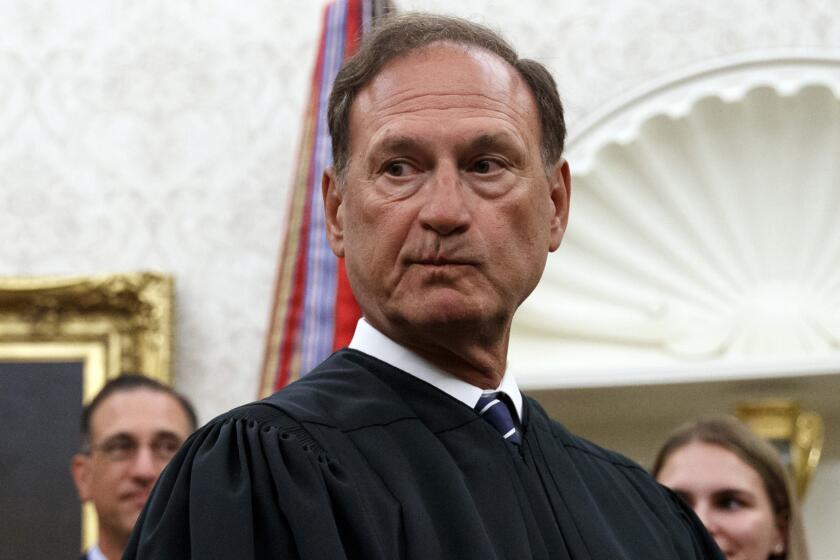The Good Life : On First Day of Its Second Century, ‘First Pres’ Has Just Begun to Serve, Pastor Says
- Share via
Rosemary Wineland knew she’d need it, so she tucked it into her sheaf of choir music and joined the other robed singers Sunday morning as they prepared to celebrate the 100th anniversary of the First Presbyterian Church of Burbank.
The Kleenex came in handy. All around the spacious sanctuary on East Olive Avenue, the eyes of many among the 350 that witnessed the church’s centennial service were wet. The yearlong celebration of the church’s anniversary concluded, in a moment underscored by the pumping of the organ, with a heartfelt sermon and the blending in song of emotion-laden voices.
“It’s so moving,” said Wineland, a Burbank real estate broker who joined the church 24 years ago. “I’m so proud we’ve been around for a century--5% of Christianity’s 2,000-year history.”
Oldest in Community
Founded 100 years ago to serve the then-agricultural community of Burbank, the First Presbyterian Church claims to be the oldest religious organization in the community. So does the First Methodist Church of Burbank, which celebrated its centennial three years ago. Neither church worships in its original building.
“We did a complete historical compilation, and according to historical records, our first church building was built in 1884, making us the oldest in the city,” said the Rev. Larry Stamper of the First Methodist Church.
“They began meeting before we did, but we had the first building,” said Betty Gardner, archivist and historian for the First Presbyterian Church.
The rivalry is good-natured. Neither church claims that its records are historically accurate, and both mention a history of cooperation that dates to the early days when the young churches shared silverware and place settings.
In the 1880s, when the churches were founded, Burbank was a community composed of pioneers from the Midwest. As the city grew, so did the churches’ membership. By the late 1920s, when Don Smith’s family moved to Burbank, the city had about 2,000 residents, 150 of whom belonged to the First Presbyterian Church.
Smith, a member of the church for 61 years, said he remembers running around the clapboard building that was the church’s third house of worship.
The first structure, built in 1888, a year after the church was founded, blew down in a windstorm; the second burned to the ground. Today’s modern structure at the corner of Olive and 5th streets was built during the late 1950s, when the church reached its peak of 1,300 members, a reflection of Burbank’s growing post-war population. Its monolithic concrete is a far cry from the graceful wood building that Smith remembers.
“We’d like to have a Gothic cathedral, but we can’t afford it,” said the Rev. Fred Appleton, a former pastor of the church. “Anyway, people are more important than steeples.”
That statement could be the church’s motto. The emphasis has always been on people, not pomp, at the “First Pres,” as it is affectionately called.
“When I had pneumonia and bursitis and my wife was laid up with two knee operations, the church fed us,” said Randolph Hedger, 77, a member of the church for 34 years.
Many of the church’s members have belonged for decades, and their ties to each other are strong. Adley Stoltz said those ties made it difficult to move to Australia three years ago to join her daughters. Stoltz flew back to celebrate the church’s 100th birthday.
“I never really left it behind--the wonderful friends and memories,” she said.
Building Needed
Outside the sanctuary after the centennial service Sunday, Stoltz and others reminisced about the history of the church. Fresh in their minds was a reminder during the sermon of the church’s need to initiate a building program. Because it lacks a sprinkler system, the church’s second story was recently declared unsafe for small children by the city’s Fire Department.
“We may have to build a new building block by block,” the Rev. William H. Craig, the current pastor, had said. “Can you see doing that?”
Decades ago, church members did just that, erecting two portions of the existing structure themselves and financing them solely with donations. That was in the late 1950s, before rising housing costs made it more difficult for young people to buy homes in the area.
Today, when the average age of the 550-member congregation is 50, hands-on labor may not be a viable option. Yet, young couples with children are joining the church in increasing numbers, Craig said.
“The people here are so friendly,” said Corry DeRobertis, a registered nurse in his 30s who officially joined the church Sunday after eight weeks of religious education. “It’s like a big family.”
But it’s not a self-centered family. A mentally disabled, homeless woman who ranted during an outdoor reception after the service was brought coffee, given money and soothed by church members.
Five years ago, when the church remodeled its sanctuary, it gave 10% of the cost of the renovation to the Loresho Community Church in Nairobi, Kenya. Its women’s groups have been active in prison reform for decades. In January, the church will expand its human services program and begin feeding the hungry on one Saturday each month in its own kitchen. It now donates food through the local Episcopal church.
“I am reminded of that song,” Craig said at the conclusion of the service. “On the first day of our second century, we have only just begun . . . to serve.”
Sign up for Essential California
The most important California stories and recommendations in your inbox every morning.
You may occasionally receive promotional content from the Los Angeles Times.







